Carlos Mejia Godoy Turns 80 in Exile
with music, painting, books and a documentary film
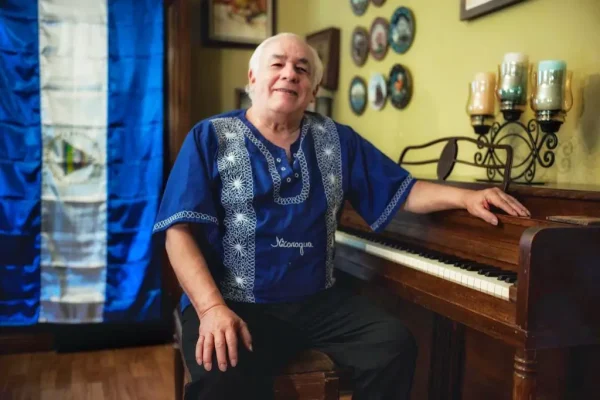
The book “Y el verbo se hizo canto” is already on sale. Soon he will launch “Los sobrinos de Monseñor”, and also have his first painting exhibition
By Katherine Estrada Tellez (Confidencial)
HAVANA TIMES – After three years of living in exile in the United States, Nicaraguan singer-songwriter Carlos Mejia Godoy talks about his exile, his new books, his experience with painting, concerts and the different projects he has taken up as his 80th birthday approaches.
The musician who wrote and performed much of the song book of the Sandinista Revolution faced exile again in 2018, for fear of reprisal by the Ortega-Murillo regime. His songs “Nicaragua, Nicaraguita,” “Viviras Monimbo,” resounded in the marches of the April 2018 Rebellion. And to the rhythm of the “Danza Negra,” he composed “Monimbo siempre con vos,” inspired by the students’ struggle.
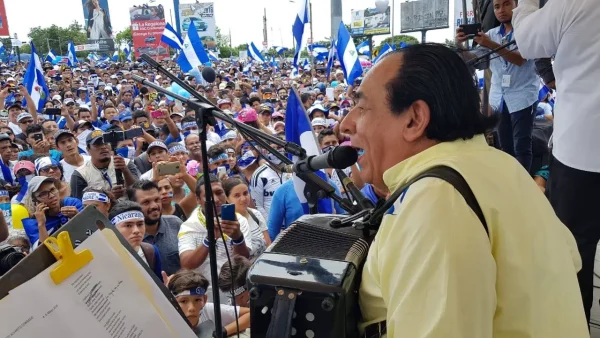
Carlos Mejia Godoy arrived in Costa Rica with his wife Xochitl Jimenez. For the first two years he kept up a promotional tour of his album, “Heroes de Abril”, between Costa Rica and the United States. “I kept coming and going, but in 2020 the pandemic caught me in Sonoma, California and I couldn’t leave,” he recounted. Since then, he has been living in that county.
The cancellation of the tour and his new start in the United States, led him to take refuge in painting and literature. “I started to let my hand go with drawing, watching YouTube tutorials to learn the techniques with acrylic, pen and ink, watercolor. And I began to sell those paintings among my contacts and in local activities. I made enough money for the gallopinto,” he recalls.
“And the verb became song”
The singer-songwriter had previously written two books in Nicaragua: “La republica de los pajaros” and “La pastorela nicaraguense”. But exile prompted him to finish “Y el verbo se hizo canto” (And the verb became song).
The work includes the stories behind 50 of his songs. “The only song that I incorporate here that does not belong to me is “Son tus perjumenes mujer,” an anonymous song of public domain to which I wrote the music. He wrote some of the anecdotes in Nicaragua and managed to publish them in a supplement of La Prensa newspaper.
Mejia says that the title is a play on words of the biblical phrase “and the word became flesh” and the selection of 50 songs comes from the “bar 50 bocas,” a place he frequented in Leon during his student days.
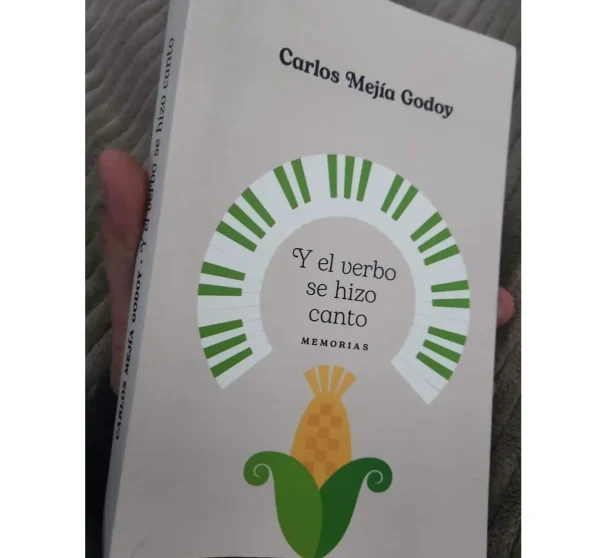
The songs were selected by friends and fans who accompanied him in the concerts. “The songs that they most requested or recognized are in the book,” he assures. The first anecdote is about Alforja campesina, which was also the first song he wrote when he was 17 years of old. The last anecdote at the end of the book is on Monimbo siempre con vos.
The book is full of many feelings, humor, love and rebellion. Mejia thanked Nicaraguan writer Sergio Ramirez for his advice and Mario Urtecho for his editing. “I am very strict with what I write and try to give the best of myself to my audience,” he emphasized.
Since March 2023, the digital version of the book is for sale on Amazon. It can also now be purchased in printed version, at a cost of 25 dollars.
His paintings are “naïve impressionist”
In September 2023, Carlos Mejia Godoy will present his first exhibition of paintings in San Francisco, California, where he will exhibit more than 25 works in the “naïve impressionist” style, which reflects the nostalgia, memories and yearnings for his origins. “All the love I feel for Somoto, and what it has meant to live here will be reflected in the paintings,” he explains.
His style is still in process, he is still experimenting, but he calls it “naïve impressionist,” making reference to the school of primitive art known as “naïve” and impressionism. Although he has developed some techniques through tutorials on YouTube, as a child he and his siblings received painting classes from renowned Nicaraguan painter Manuel Garcia Moia. “I used to do caricatures as a child, I would look at people’s faces and draw them.”

“Among my brothers, Armando was the one who began in primitive painting. The eldest, Chico Luis, worked in pen and ink. He drew traditional houses. Luis Enrique has his own style; he draws colorful figures inspired by indigenous cultures,” he explains.
Carlos is still putting the finishing touches on some of the paintings that will be in the exhibition. The event will be announced soon through his Facebook page.
“Monsignor’s Nephews”
Mejia is also working on his second literary piece in exile entitled “Los sobrinos de monseñor” (Monsignor’s Nephews), which details his childhood adventures with his siblings when they moved to Managua to live with their uncle Luis Enrique Mejia Fajardo, who at that time was monsignor at the Metropolitan Cathedral “Santiago Apostol” of Managua, known also as the old cathedral.
“My brothers and I were influenced by him, who was a kind of family tutor. The work goes beyond our experiences, between reality and fantasy, it reveals all the adventures, teachings, mischiefs, and reprimands that we went through with that character, because he was quite a character, with an impressive nature,” he says.
Monsignor’s Nephews is the continuation of the book written by his brother, “Relincho en la sangre”, and he hopes to finish it before the end of the year.
Eighty Junes and his documentary “Living in Exile”
On June 27, the Nicaraguan singer-songwriter turns 80 years old. He began to celebrate it since May 18 with an exhibition of his paintings and the premiere of the documentary Living in Exile, Carlos Mejia Godoy, which was directed by filmmaker Jon Silver and narrates the life of the singer-songwriter in exile.
Silver is a documentary filmmaker who visited Nicaragua since the 80s and knows the history of the Sandinista Revolution and the artistic career of the Mejia brothers. Carlos Mejia Godoy’s meeting with the filmmaker was purely by chance. “He is a neighbor of a person who works with my sister and when he found out that I was here he suggested that I make the documentary,” said Silver.
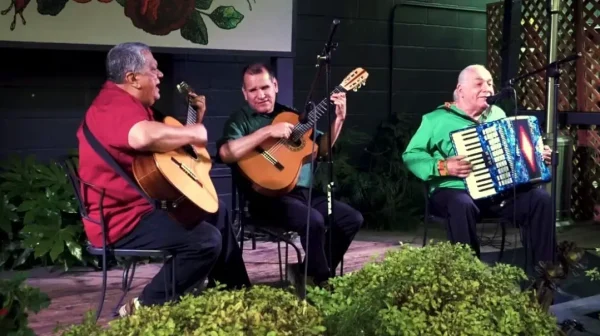
Ten paintings representing his artistic development during the three years he has been in exile were also exhibited at the event. “I did not want to sell any of them, because they are paintings that I am preparing to take to the exhibition in San Francisco. It was a space to show what I have been working on and share with the community. We sang, danced, and enjoyed ourselves,” he describes.
Future Projects
As a future project, he plans to make an oratory for the Michiguiste River in Somoto, one of the many tributaries of the Coco River, which allowed Carlos Mejia and many other children to live a happy childhood. But, over the years and the apathy of the population, it dried up.
He wants to celebrate the remembrance of this “river that was a friend,” and with whom he lived many adventures in his childhood through an oratory of twelve songs. “This work began with a musical theme without lyrics and, like the river itself, which was born from a spring and from that emerged into a long waterway, I have more or less a 25 minutes of production,” he explains.
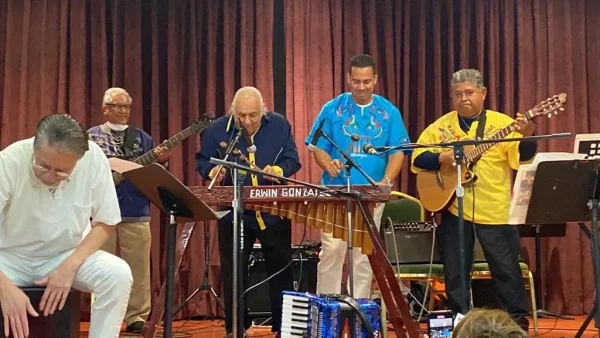
In the oratory, Mejia wants to express everything that that makes his heart turn to that place that marked his life and which he recalls with nostalgia. “Utopia will be the end of the work. I want the children of Somoto, along with this child that prevails in me, to ask the river to return, with the certainty that this new generation will be committed to care and value it.”
Mejia also plans to make paintings of 80 musical themes. “I don’t know if I will be alive to make them all, but I have them in order of priority and one of the interesting things is a tribute to famous painters like Picasso, Dali, Van Gogh, when they arrive in Somoto. So, I am immersed in painting each one with their style,” he concludes.





